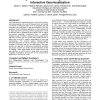Free Online Productivity Tools
i2Speak
i2Symbol
i2OCR
iTex2Img
iWeb2Print
iWeb2Shot
i2Type
iPdf2Split
iPdf2Merge
i2Bopomofo
i2Arabic
i2Style
i2Image
i2PDF
iLatex2Rtf
Sci2ools
GIS
2008
ACM
2008
ACM
Charting new ground: modeling user behavior in interactive geovisualization
Geovisualization has traditionally played a critical role in analysis and decision-making, but recent developments have also brought a revolution in widespread online access to geographic data and integration tools, particularly for map-based interfaces. This next generation of geovisualization applications is often characterized by high interactivity and strong end-user participation in both development and use. Building the most effective tools to support user-centered geographic visualization faces a significant challenge, though: very little is known about how people interact with maps. To date, map use research has typically focused on higher order use goals or cognitive interpretations of static map representations. Our research employs Human-Computer Interaction approaches in order to investigate user behaviors that contribute to interactive map use and understanding. This paper describes our approach to studying geovisualization interaction and presents our pilot user studies ...
Database | GIS 2008 | Initial Interaction Model | User Interfaces | User-centered Geographic Visualizations |
| Added | 09 Nov 2009 |
| Updated | 09 Nov 2009 |
| Type | Conference |
| Year | 2008 |
| Where | GIS |
| Authors | David C. Wilson, Heather Richter Lipford, Erin Carroll, Pamela Karr, Nadia Najjar |
Comments (0)

